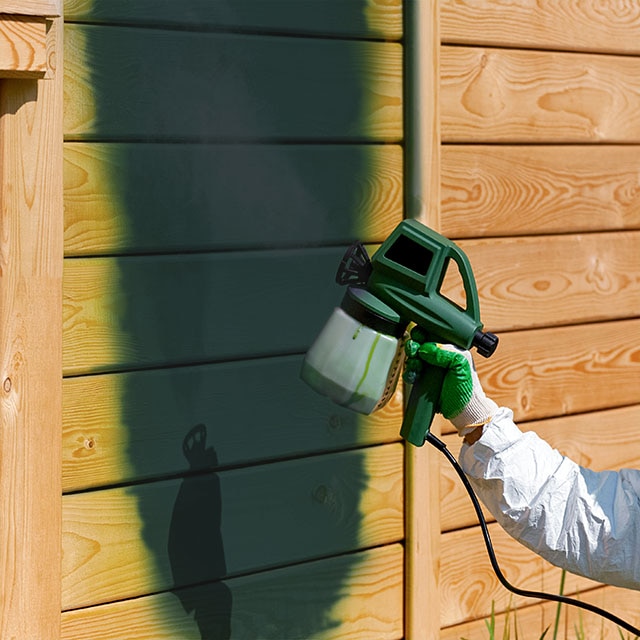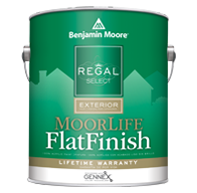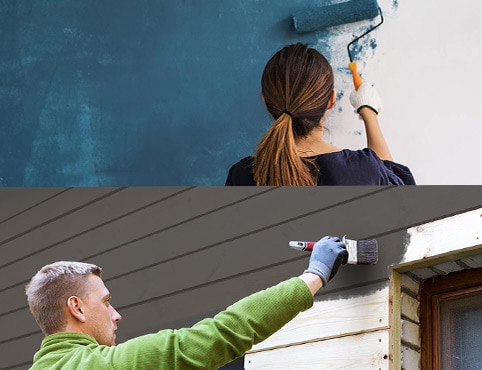There are different application methods you can use once you decide to paint your home’s exterior: You can go the tried-and-true route of using a paintbrush and roller, or opt to cover more area at once using a paint sprayer.
Using a paint sprayer requires a certain level of expertise that may go beyond the reach of an average DIY-er. We recommend using a professional painter for this method, however, if you are committed to spraying, your local Benjamin Moore retailer can coach you on this topic.
It is important to keep in mind that even the best spray painting techniques require a lot of preparation and patience. Follow manufacturer’s instructions, product technical data sheets, and our tips below to see how to use a paint sprayer and give your home the lasting makeover it deserves.
Preparing to Spray Paint
Step #1: Check the Weather
Outdoor painting begins and ends with the weather. While the perfect outdoor painting day comes with lower humidity and the temperature around 77°F, being able to adjust with the forecast is imperative to a successful exterior painting job.
It is important to choose a dry day for spray painting, as rain can take your hours of hard work and turn a fresh coat of paint into a streaky, runny mess. Keep temperature front of mind, as well, as you want to refrain from spraying when the temperature drops below 40°F, and monitor humidity levels, especially if working in cooler weather. Low temperatures and high humidity are a bad combination, as high humidity slows down drying time.
Wind is a factor, too. Strong gusts may cause overspray during painting.
Also, because the paint from a sprayer may go beyond the painting surface, remember to move any items, like outdoor furniture or barbecue grills, far from the spraying area. Additionally, remove any hardware from your home and clearly define the area you want to spray, using painter’s tape and paper to mask off any area not designated for painting, including windows.
Step #2: Clean, Dull, Dry
Exterior surfaces must be pressure washed prior to priming or painting; this ensures that chalk or dirt is removed to allow for maximum adhesion. If you are power washing your home with anything other than water (e.g., a cleaning solution like Benjamin Moore Clean (318) or bleach, in cases of stains from mold or mildew), be sure to cover plants and landscaping with taped-down plastic drop cloths.
Un-weathered areas such as eaves, ceilings, and overhangs should be washed with a detergent solution and/or rinsed with a strong stream of water from a garden hose to remove contaminants that can interfere with proper adhesion.
Wait until the walls are sufficiently dried, then give the surface a thorough inspection. Any visible damage must be repaired, including protruding nails. Remove and sand any peeling or flaking paint down to a smooth surface.
Any surface painted in high gloss requires sanding, as well. While most exterior houses aren’t painted with a high gloss finish, many doors are. If you encounter a surface that is high in gloss, be sure to de-gloss with sandpaper or a liquid de-glosser, available at home improvement stores.
Step #3: Prime the Surface
We recommend always priming prior to caulking and patching. If not priming the entire home, take care to spot prime (applying primer to particular areas) any surface areas that have been repaired and/or sanded. Brick exteriors should be primed entirely.
Step #4: Caulk
Ask your local Benjamin Moore retailer to recommend a high-quality paintable caulk to fill minor cracks and gaps around windows and doors. Caulk between one piece of siding to the next and in between flashing (the metal strips that keep water out). The smoother your surface, the more uniform your paint job will be.
Spray Paint Safety
Before using a sprayer, familiarize yourself with the basics of how they work, and understand the precautions necessary while using them. Paint sprayers and spray paint work by creating pressure, with air or without, to force a steady stream of product onto a surface. Powered by electricity or gasoline, sprayers cover much more surface area in less time than traditional brush painting.
Under no circumstances should you use a paint sprayer without the proper protective gear. Use a mask or respirator while spraying, protect eyes with goggles, and make sure that your hair is covered. Wear a painter’s suit to reduce exposure to skin.
Paint sprayers are extremely powerful machines that can cause harm if improperly used. Follow manufacturer’s directions at all times, and never point a sprayer at yourself or anyone else while in use.
How to Use a Paint Sprayer
Before you begin spray painting, make sure your sprayer is completely clean, and research which paint and spray tips are right for your project. Different paints and coverage areas require different spray paint tips; typically, you’ll need a wider tip for larger surfaces, and a narrower one for smaller, more intricate areas.
High-quality exterior paint will deliver better coverage and color upon application. We love fade-resistant Regal® Select Exterior and its mildew-resistant finishes, available in more than 3,500 spray paint-ready colors. Refer to product technical data sheets for information or ask your local Benjamin Moore retailer for assistance on spray paint techniques if you are entirely new to spray painting. We suggest that you begin spraying on the side of the house, in indirect sun if possible, for two reasons:
-
1) Direct sunlight can cause paint to dry too quickly, and can cause a host of issues, including lap marks and blistering.
2) The location is forgiving to first-time mistakes, allowing you to try out different settings and find your comfort zone.
Spray the undersides of any eaves or awnings first, then cut in corners and around windows. When the corners are finished, follow construction lengthwise, starting from the top of the exterior wall.
When spraying the bottom third of the wall, keep the sprayer directed at the surface, and not tilted down towards the ground. This will prevent overspray from hitting the foundation.
How to Spray Paint Evenly
It is crucial not to rush the spray painting process; a slow, steady pace is how you ensure your home ends up painted beautifully. Paint comes out of a sprayer much faster and heavier than when applied with a brush, so one of the biggest challenges when spraying paint is getting a uniform coat.
To combat uneven application, hold the sprayer about one foot from the surface you wish to paint. Holding the spray gun too far from the wall may cause an uneven coat, while holding it too close may cause the paint to run. Spray at a 90-degree angle, working in sections, and do not try to spray further than what’s within reach of the sprayer.
Paint in a constant motion, overlapping the paint about halfway as you spray and moving horizontally along your home. Stopping the paint spray in the middle of painting can cause too much paint to clump on the wall.
It is up to you to decide how many coats of spray paint you need. If the color is looking lighter than you would like, wait until the first coat dries completely, and then go over it again.
How Long Does It Take for Spray Paint to Dry?
The drying time of your exterior spray paint job depends mostly on the state of the weather. Ideally, you will be painting your home in sections, meaning that one part should be drying while another is painted, but colder and/or high-humidity climates will see a slower dry time, while exteriors in hotter, drier areas may dry faster.
No matter where you live, we recommend giving wet paint plenty of time to dry thoroughly, especially before doing a second coat of paint or reattaching any hardware.
How to Fix Spray Paint Drips
Due to the unpredictable factors that surround exterior painting—the wind, the humidity, etc.—even the most experienced paint sprayers see a paint drip from time to time. While there is no one way how to spray paint without drips , the problem is only cosmetic, and can be remedied after the paint has dried completely.
Here’s how to fix a drip: Use sandpaper to sand down the dried paint drip, then use a brush to repaint any light spots, taking care to blend it in with the rest of the paint on the wall.
Have More Questions? Visit your local Benjamin Moore store or contact Customer Support.


